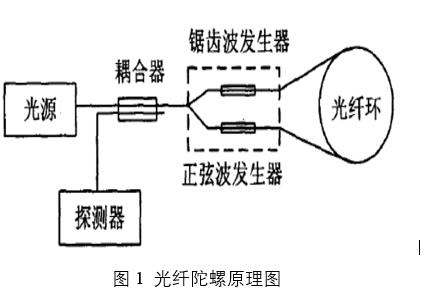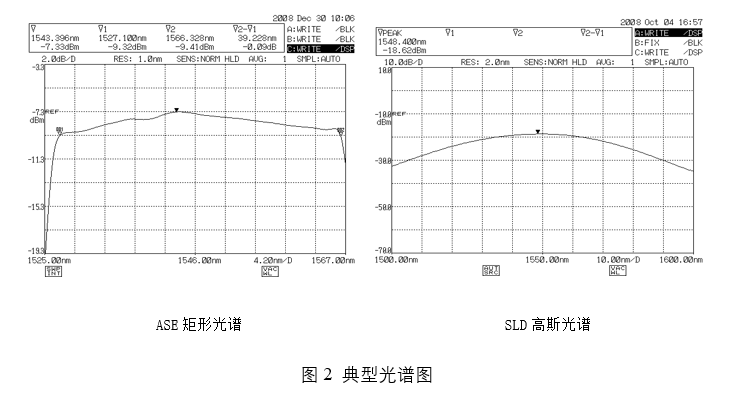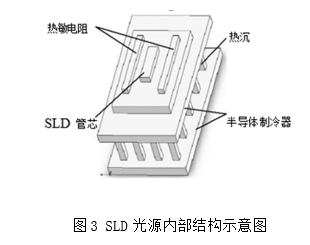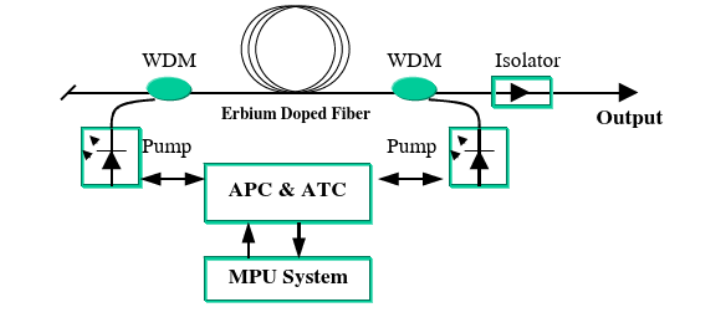Key technology of fog: broadband light source
Working principle of fog
That is to say, the phase difference of the interference signal is directly proportional to the input angular velocity of the closed optical path sensitive axis after the light wave propagating in the direction of the fast visual way returns to the starting point for interference. According to the optical circuit schematic diagram analysis, the light beam from SLD light source is divided into two beams by coupler and Y waveguide. One beam propagates clockwise after entering the fiber ring and then returns to the Y waveguide's lower arm after exiting from the fiber ring. The other beam enters the fiber ring and propagates anticlockwise after splitting through the Y-Waveguide, and then exits from the fiber ring and returns to the upper arm of the Y-Waveguide. The two beams from different channels generate the interference signal after a turn. The detector detects the intensity change of the interference signal to obtain the corresponding angular velocity change.

From the optical path structure shown in Figure 1, the innate response of fog is a cosine function. The light signal intensity detected by the detector is:
I0 is the input light intensity, and φ R is the Sagnac phase difference caused by the input angular velocity. From formula (1), they can see that the light source plays a vital role in fog (fiber optic gyroscope) as a core optical element to provide a suitable optical signal for condensation to produce the Sagnac effect. The light source used in fog requires high reliability, small volume, and long life. Also, it requires high power, low spatial coherence (broad spectrum), and weak time correlation (long-term stability of wavelength/power).
Broadband light source
At present, there are two kinds of broadband light sources used in fog: SLD light source and ASE light source. The former is a semiconductor light source in which the spontaneous emission of photons is amplified by one-way excitation. Because SLD has the function of one-way amplification, the output power can reach the MW level. It has a narrow beam divergence angle, broad output spectrum, and high stable output power of pigtail to obtain interference signal with a higher signal-to-noise ratio. ASE light source is amplified spontaneously and with higher output power, a broader spectrum, higher wavelength stability, and power stability, mostly used in the high-precision fog system. The following are typical spectra of ASE and SLD light sources:
ASE rectangular spectrum SLD Gaussian spectrum

SLD light source introduction
The internal structure of the SLD light source is shown in Figure 3. It consists of an SLD core, thermistor, heat sink, TEC, pigtail, shell, and other components. Tec is used to controlling and stabilizing the light source's core temperature; the thermistor is used to sense the change of the light source's core temperature. The heat sink has sizeable thermal conductivity and is used for heat dissipation.

Under the forwarding injection current, holes from the player and electrons from the N layer combine to emit photons in the light-emitting layer. The spontaneous emission photons are stimulated and amplified in a given cavity during the propagation process, resulting in a narrower spectrum and divergence angle, and wider modulation bandwidth. The SLD light source module's working principle is: driven by the injection current, the heat generated in the SLD operation is transferred out through the heat sink. Tec controls the temperature. The output light wave of the tube core is output through the tail fiber coupling, through the metallization of the optical fiber, to fix the relative position between the optical fiber and the chip through the metal welding to ensure the stability of the output light power. The output power of SLD will affect the output SNR of a photodetector in fog.
Introduction to ASE light source:
ASE (amplified spontaneous emission) light source is specially designed for production and laboratory experiments. The central part of the light source is the gain medium erbium-doped fiber and high-performance pump laser. The unique ATC and APC circuits ensure the output power's stability by controlling the output of the pump laser. By adjusting the APC, that can change the output power within a specific range.

The relationship between the main parameters of the light source and the performance of fog
- Influence of output power of light source on gyro noise
It is necessary to increase the fog light source's output power. Fiber optic gyroscope measures the phase difference of Sagnac produced by rotation. The measurement of phase difference is realized by detecting the change of optical power. According to the relationship between phase difference and optical power, it is limited by the limit of optical power measurement. In interferometric fog, random walk caused by shot noise is inversely proportional to the light power's square root returned to the detector. The light power returned to the sensor is related to the optical path's total loss and the light source's output power. Therefore, the output power of the light source has a significant influence on the performance of fog. The SLD light source and ASE light source's output power can reach MW level, which fully meets the requirements of navigation level fog for a light source.





















